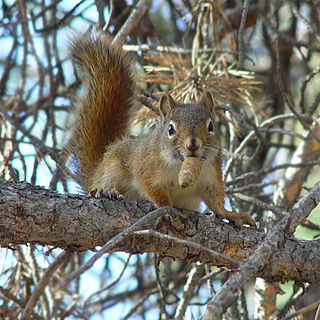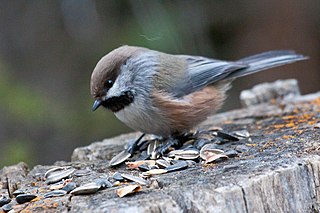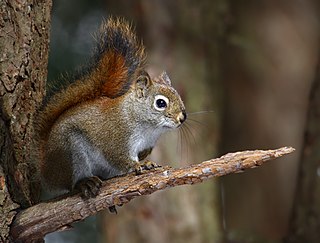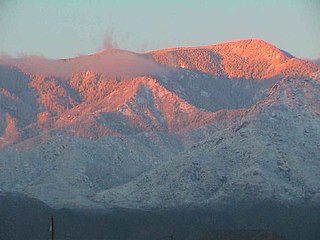
The snowshoe hare, also called the varying hare or snowshoe rabbit, is a species of hare found in North America. It has the name "snowshoe" because of the large size of its hind feet. The animal's feet prevent it from sinking into the snow when it hops and walks. Its feet also have fur on the soles to protect it from freezing temperatures.

The Canada jay, also known as the gray jay, grey jay, camp robber, or whisky jack, is a passerine bird of the family Corvidae. It is found in boreal forests of North America north to the tree line, and in the Rocky Mountains subalpine zone south to New Mexico and Arizona. A fairly large songbird, the Canada jay has pale grey underparts, darker grey upperparts, and a grey-white head with a darker grey nape. It is one of three members of the genus Perisoreus, a genus more closely related to the magpie genus Cyanopica than to other birds known as jays. The Canada jay itself has nine recognized subspecies.

Sciurinae is a subfamily of squirrels, uniting the flying squirrels with certain related tree squirrels. Older sources place the flying squirrels in a separate subfamily (Pteromyinae) and unite all remaining sciurids into the subfamily Sciurinae, but this has been strongly refuted by genetic studies.

Pine squirrels are squirrels of the genus Tamiasciurus, in the Sciurini tribe, of the large family Sciuridae.

The spotted owl is a species of true owl. It is a resident species of old-growth forests in western North America, where it nests in tree hollows, old bird of prey nests, or rock crevices. Nests can be between 12 and 60 metres high and usually contain two eggs. It is a nocturnal owl which feeds on small mammals and birds. Three subspecies are recognized, ranging in distribution from British Columbia to Mexico. The spotted owl is under pressure from habitat destruction throughout its range, and is currently classified as a near-threatened species.

The boreal chickadee is a small passerine songbird in the tit family Paridae. It is found in the boreal forests of Alaska, Canada and the northern United States and remains within this range all year. This bird is known for its high pitched trill patterns used in communication with other birds and food storage habits in preparation for winter months.

The Douglas squirrel is a pine squirrel found in western North America, from the Pacific Northwest to central California, with an isolated subspecies in northern Baja California, Mexico. It is sometimes known as the chickaree or pine squirrel, although these names are also used for the American red squirrel. Variant spellings of the common name are Douglas' squirrel and Douglas's squirrel. The Native Americans of Kings River called it the "Pillillooeet", in imitation of its characteristic alarm call.

The Fraser fir, sometimes spelled" Frasier fir, is an endangered species of fir native to the Appalachian Mountains of the Southeastern United States. They are endemic to only seven montane regions in the Appalachian Mountains.

The American red squirrel is one of three species of tree squirrels currently classified in the genus Tamiasciurus, known as the pine squirrels. The American red squirrel is variously known as the pine squirrel or piney squirrel, North American red squirrel, chickaree, boomer, or simply red squirrel. The squirrel is a small, 200–250 g (7.1–8.8 oz), diurnal mammal that defends a year-round exclusive territory. It feeds primarily on the seeds of conifer cones, and is widely distributed across much of the United States and Canada wherever conifers are common, except in the southwestern United States, where it is replaced by the formerly conspecific southwestern red squirrel, and along the Pacific coast of the United States, where its cousin the Douglas squirrel is found instead.

Abert's squirrel or the tassel-eared squirrel is a tree squirrel in the genus Sciurus native to the southern Rocky Mountains from the United States to the northern Sierra Madre Occidental of Mexico, with concentrations found in Arizona, New Mexico, and southwestern Colorado. It is closely associated with, and largely confined to, mature ponderosa pine forests. It is named in honor of the American naturalist John James Abert; nine subspecies are recognised. It is recognizable by its tufted ears, gray color, pale underparts and rufous patch on the lower back. The squirrel feeds on the seeds and cones of the Mexican pinyon and the ponderosa pine when they are available, but will also take fungi, buds, bark, and carrion. Breeding normally occurs in summer, with a spherical nest being built high in the canopy.

The Pinaleño Mountains, are a remote mountain range in southeastern Arizona, near Safford, Arizona. The mountains have over 7,000 feet (2,100 m) of vertical relief, more than any other range in the state. The mountains are surrounded by the Sonoran-Chihuahuan Desert. Subalpine forests cover the higher elevations. According to The Nature Conservancy, they traverse five ecological communities and contain "the highest diversity of habitats of any mountain range in North America." The highest point is Mount Graham at 10,720 feet (3,267 m). Locals often refer to the whole mountain range as "Mount Graham", in which case the peak is referred to as "High Peak". The mountains cover 300 square miles (780 km2) and are part of the Coronado National Forest, Safford ranger district.

The gray-footed chipmunk is a terrestrial and forest-dwelling species of chipmunk and rodent in the family Sciuridae. It is endemic to New Mexico and in the Sierra Diablo and Guadalupe Mountains in the Trans-Pecos region of Texas in the United States. Its natural habitat are coniferous forests. First discovered in 1902, they are distinguished by the unique gray dorsal colouring on the hind feet, hence the common name. They demonstrate sexual dimorphism, and the female is larger than the male.

Mearns's squirrel is a subspecies of the Douglas squirrel endemic to Mexico. It is endangered and occurs in low densities, and is threatened by habitat loss. It is possibly also threatened by competition from the eastern gray squirrel, which was introduced to the range of Mearns's squirrel in 1946, but may not be present anymore. It is closely related to other subspecies of the Douglas squirrel, but far less is known about its behavior, which was first studied in detail in 2004. It is named for the 19th-century American naturalist Edgar Mearns.

The robust cottontail or Holzner's cottontail is a species of cottontail rabbit native to high-altitude regions of the southwestern United States and western Mexico.

There are at least 50 small mammal species known to occur in Yellowstone National Park.

There are at least 14 large mammal and 50 small mammal species known to occur in Glacier National Park.

The Mount Graham red squirrel is an endangered subspecies of the southwestern red squirrel native to the Pinaleño Mountains of Arizona. It is smaller than most other subspecies of red squirrel, and also does not have the white-fringed tail that is common to the species. Its diet consists mainly of mixed seeds, conifer cones and air-dried fungi. It exhibits similar behavior to other squirrels in its species.

The Arizona Mountains forests are a temperate coniferous forests ecoregion of the southwest United States with a rich variety of woodland habitats and wildlife.

The ecology of the Rocky Mountains is diverse due to the effects of a variety of environmental factors. The Rocky Mountains are the major mountain range in western North America, running from the far north of British Columbia in Canada to New Mexico in the southwestern United States, climbing from the Great Plains at or below 1,800 feet (550 m) to peaks of over 14,000 feet (4,300 m). Temperature and rainfall varies greatly also and thus the Rockies are home to a mixture of habitats including the alpine, subalpine and boreal habitats of the Northern Rocky Mountains in British Columbia and Alberta, the coniferous forests of Montana and Idaho, the wetlands and prairie where the Rockies meet the plains, a different mix of conifers on the Yellowstone Plateau in Wyoming, the montane forests of Utah, and in the high Rockies of Colorado and New Mexico, and finally the alpine tundra of the highest elevations.

Okanagan dry forests is a temperate coniferous forest ecoregion in the Pacific Northwest of North America, as defined by the World Wildlife Fund (WWF) categorization system. It is closely associated with the Okanagan region of British Columbia and Washington. Only 20% of the ecosystem is still intact, and continues to be under threat for preservation due to land clearing and urban expansion, alongside the increasing threats of fire and extreme weather due to climate change.





















